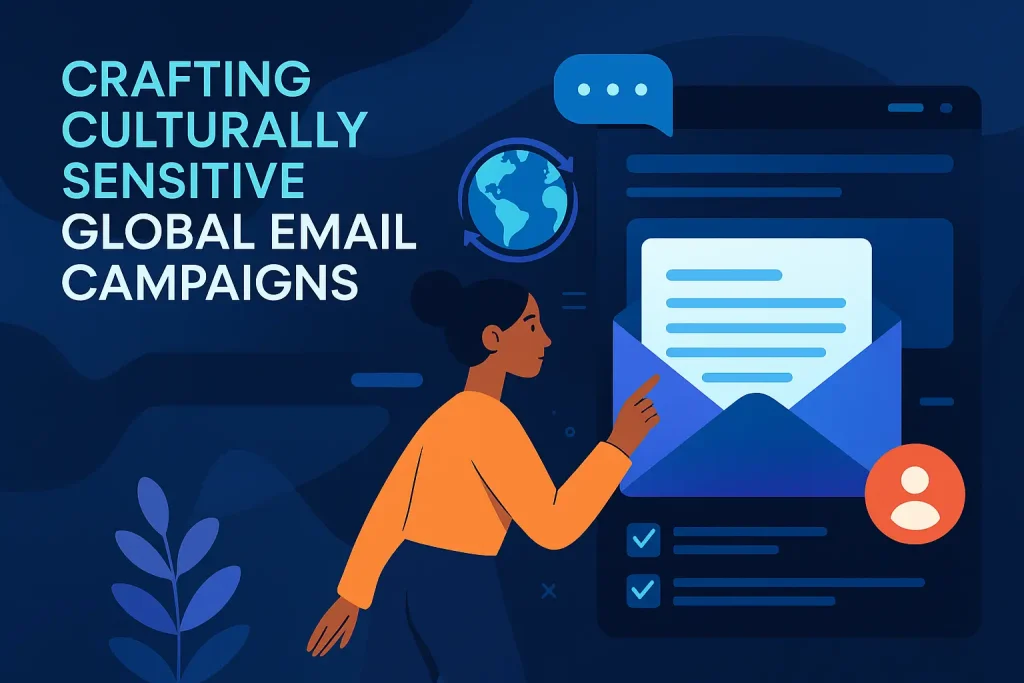
In today’s world, businesses are reaching out to people all over. Email marketing is a strong tool for connecting with people everywhere.
But, these campaigns must fit with different cultural backgrounds. It’s important to understand and respect these differences. This way, we can avoid causing offense and get better results.
By being culturally sensitive, businesses can do better with their email marketing. This article will show you why it’s important. It will also give you tips to make your global email campaigns better.
Table of Contents
The Importance of Cultural Sensitivity in Global Email Marketing
Global email marketing needs to understand and respect different cultures. It’s not just about avoiding mistakes. It’s about making a real connection with your audience.
Knowing your audience’s culture helps tailor your messages. It’s more than just translating words. It’s about knowing their values and likes.
Why Cultural Awareness Matters in Email Campaigns
Cultural awareness is key because it affects how your message is seen. When you’re culturally sensitive, your emails connect better. This leads to more people taking action.
Diversity awareness in emails is key for global brands. It means knowing your audience’s culture and adjusting your content. This includes respecting their holidays and customs.
| Cultural Aspect | Importance in Email Marketing | Example |
|---|---|---|
| Language and Translation | Accurate translation and consideration of local dialects | Using professional translation services to ensure cultural nuances are preserved |
| Cultural Norms and Values | Avoiding content that may be considered offensive | Understanding that certain images or gestures may have different meanings in different cultures |
| Local Customs and Holidays | Timing email campaigns around local events and holidays | Sending holiday greetings or special offers during culturally significant events |
The Business Impact of Culturally Sensitive Communication
Being culturally sensitive has big benefits for businesses. It leads to more people engaging with your emails. This means better brand image and more money.
By focusing on cultural sensitivity, you stand out in a busy market. This approach makes your emails more effective. It also helps build a positive brand image around the world.
Understanding Cultural Dimensions in Communication
In global email marketing, knowing cultural differences is key. Cultural dimensions affect how messages are seen and understood. This is important for success.
Marketers can make their emails better by knowing these cultural differences. It’s not just about translating words. It’s also about making the message fit with the culture and values.
Hofstede’s Cultural Dimensions Theory Applied to Email Marketing
Hofstede’s Cultural Dimensions Theory helps us understand cultural differences. It talks about several important areas: Power Distance Index (PDI), Individualism vs. Collectivism (IDV), Uncertainty Avoidance Index (UAI), Masculinity vs. Femininity (MAS), Long-Term Orientation (LTO), and Indulgence vs. Restraint (IVR).
For email marketers, knowing these areas helps make messages that fit the culture. For example, in cultures with high PDI, emails should show more respect and deference to authority.
| Cultural Dimension | Email Marketing Implication |
|---|---|
| Power Distance Index (PDI) | Use formal language in high PDI cultures |
| Individualism vs. Collectivism (IDV) | Focus on individual benefits in high IDV cultures |
| Uncertainty Avoidance Index (UAI) | Provide clear, detailed information in high UAI cultures |
High-Context vs. Low-Context Communication Styles
There’s a big difference between high-context and low-context cultures. High-context cultures use a lot of implicit communication and shared knowledge. Low-context cultures like clear, direct communication.
Emails for high-context cultures should be more subtle, using shared knowledge. Emails for low-context cultures should be straightforward and easy to understand.
By using these cultural insights, marketers can make their global email campaigns better. This leads to more engagement and sales.
Cultural Sensitivity in Global Email Campaigns: Core Principles
When sending emails worldwide, it’s key to be respectful. This means knowing the local customs and values. It also means using the right language and avoiding any words that might offend.
Being sensitive in email communication is very important. It helps build trust and respect with people from different cultures. It shows that you care about their feelings and values.
Creating inclusive email campaigns is also vital. This means making sure everyone feels welcome and valued. It’s about avoiding language or images that might make some people uncomfortable.
By following these core principles, you can make your emails more effective. You’ll reach more people and build stronger relationships. It’s all about being respectful and inclusive in your email campaigns.
Researching Your Target Markets

Cultural market research is key for global email marketing success. Knowing your audience’s cultural nuances is vital. It helps make campaigns that connect with different groups.
To research your markets well, mix qualitative and quantitative methods. You’ll need data on cultural trends and consumer behavior.
Effective Methods for Cultural Market Research
There are many ways to do cultural market research. Here are a few:
- Surveys and questionnaires to get direct feedback.
- Social media listening to catch cultural trends.
- Market analysis reports for insights into regional preferences.
- Focus groups for in-depth cultural views.
Forrester says, “Knowing cultural differences is vital for global marketing.” This shows how important deep research is.
| Research Method | Description | Benefits |
|---|---|---|
| Surveys | Direct feedback from target audience | Provides quantitative data on consumer preferences |
| Social Media Listening | Monitoring social media trends and sentiments | Offers real-time insights into cultural trends |
| Market Analysis Reports | Detailed reports on market trends and behaviors | Gives complete insights into regional preferences |
Creating Cultural Personas for Different Regions
Creating cultural personas means making detailed profiles of your audience. These profiles help tailor campaigns to fit specific cultures.
A cultural persona includes demographic info, cultural likes, values, and behaviors. For example, a young person in a collectivist culture might value family and community.
Using cultural personas, marketers can make email campaigns that really speak to their audience.
Language and Translation Considerations

Good international email marketing is more than just translating. It’s about knowing cultural and language differences. As businesses grow, talking to people in different languages and cultures is key.
Email marketing is not just about translating words. It’s about sending the right message, feeling, and tone to different people. This is where transcreation is important.
Beyond Direct Translation: Transcreation Strategies
Transcreation means making content fit the culture, not just translating it. It needs a deep understanding of local culture, sayings, and likes. This way, the content feels like it’s from the audience.
For example, a good transcreation plan might include:
- Changing images and tone to match local tastes
- Using local sayings and words that connect with the audience
- Making sure the content is right for the culture and is careful
Handling Idioms, Humor, and Cultural References
Idioms, jokes, and cultural references can be tricky to translate. What’s funny or makes sense in one place might not in another. It’s important to get these to avoid misunderstandings.
For example, here’s a table showing some American sayings and how they might be seen differently elsewhere:
| American Idiom | Meaning | Potential Misinterpretation |
|---|---|---|
| “Break a leg” | Good luck | Literally wishing harm |
| “Cost an arm and a leg” | Something is very expensive | Literal interpretation of physical cost |
Working with Native Translators and Cultural Consultants
To make sure your email campaigns are right for different cultures, work with native translators and cultural experts. They know local customs, likes, and language details. This helps you avoid mistakes.
By using transcreation and the help of native translators and experts, businesses can make email campaigns that connect with people all over the world.
Visual Elements and Design Across Cultures

Global email campaigns need to be careful with their visuals. As companies reach out to more places, knowing how people see things is key. This helps them connect well with people all over.
Things like colors, pictures, and how things are laid out matter a lot. What looks good in one place might not in another. So, it’s important to change how emails look to fit different cultures.
Color Symbolism Around the World
Colors mean different things in different places. For example, white means purity in the West but mourning in Asia. Red is lucky in China but warns of danger in the West. Knowing this helps pick colors that people will like.
- In Japan, red and white are considered auspicious colors.
- In South Africa, red is associated with mourning.
- In India, saffron (a shade of orange) is considered sacred.
Image Selection for Diverse Audiudences
Choosing the right images is very important. Pictures that show respect and fit the audience can make emails better. Using people from different backgrounds or showing local life can make emails feel more real.
Layout and Design Preferences by Region
How people like to see things also changes by place. Western folks like things simple and left-aligned. But others might read from right to left or have different ideas about pictures and text. Knowing these helps make emails that work better.
By paying attention to these cultural differences, companies can make emails that work for everyone. This helps them connect better with people all over and makes their brand more welcoming.
Timing and Scheduling for Global Campaigns

Global email marketing needs smart timing and scheduling. Emails do better when sent at the best time. This means knowing your audience’s holidays and time zones.
Religious and Cultural Holidays to Consider
Knowing big holidays is key for global email plans. Sending emails on holidays can upset people. For example, emails on Christmas or Diwali might not work well. Learning and respecting these holidays helps a lot.
Some big holidays to watch out for include:
- Eid al-Fitr and Eid al-Adha in Islamic countries
- Diwali in India and other Hindu-majority countries
- Chinese New Year in China and other East Asian countries
- Christmas and New Year’s in Western countries
By skipping these times or making emails respectful, you can get better results.
Optimal Send Times Across Different Time Zones
It’s not just about holidays; it’s also about optimal send times across zones. You want your email to be opened when it’s most likely.
| Region | Optimal Send Time (Local Time) |
|---|---|
| North America | Tuesday, 10 AM |
| Europe | Wednesday, 9 AM |
| Asia-Pacific | Thursday, 8 AM |
Getting these details right can make your global emails much better. It shows sensitivity in email communication and keeps your audience interested.
Legal and Compliance Considerations

International email marketing rules are complex. Businesses need to follow many laws when sending emails worldwide. This is key for global campaigns to succeed.
Navigating GDPR, CAN-SPAM, and Regional Regulations
The General Data Protection Regulation (GDPR) in the EU and the CAN-SPAM Act in the US are big rules. GDPR is about getting consent and protecting data. CAN-SPAM lets people choose not to get emails. Knowing these rules and others is very important.
| Regulation | Key Requirements | Geographic Scope |
|---|---|---|
| GDPR | Consent, Data Protection, Right to Erasure | European Union |
| CAN-SPAM | Clear Opt-out Mechanism, Truthful Subject Lines | United States |
| Regional Laws | Varies by Region (e.g., CASL in Canada) | Varies |
Privacy Concerns Across Different Cultures
Privacy views change a lot between cultures. This affects how people see email marketing. Knowing these differences helps make inclusive email campaigns that fit local values.
By understanding legal rules and cultural views on privacy, companies can win trust worldwide. This makes their email marketing successful globally.
Testing and Optimizing for Different Markets
Global email marketing needs a careful approach. This includes testing and tweaking for many cultures. It’s about knowing what each culture likes and does to make emails just right.
This work never stops. It’s about keeping emails fresh and effective everywhere. It mixes data, cultural knowledge, and creativity.
A/B Testing Across Cultural Segments
A/B testing is a key tool in email marketing. It lets marketers see which email version works best. This is super helpful when testing across cultures.
For example, a company might test two email subject lines. One is simple and direct, the other is fun and playful. The results show what each culture likes more.
Gathering and Implementing Cultural Feedback
It’s important to listen to what people think about emails. This can be through surveys, groups, or social media. It helps understand how emails are seen in different cultures.
Using this feedback means changing emails to fit what people want. This could be changing pictures, the tone, or when emails are sent.
Continuous Improvement Strategies
Improving email marketing over time means always checking how it does. This can be done by:
- Looking at how many people open, click, and buy.
- Keeping up with what’s new in cultures.
- Always listening to what people say about emails.
By doing these things, marketers can keep their emails working well and respectful of cultures.
| Cultural Segment | Preferred Communication Style | Optimal Email Frequency |
|---|---|---|
| Western Cultures | Direct and Informal | Weekly |
| Asian Cultures | Polite and Formal | Bi-Weekly |
| Latin American Cultures | Warm and Personal | Monthly |
Case Studies: Successful Culturally Sensitive Email Campaigns
Global email marketing works best when it respects different cultures. Looking at successful campaigns can teach marketers a lot. They can learn how to reach people all over the world.
Global Brands That Got It Right
Some big brands have done well with culturally sensitive emails. For example, Coca-Cola made emails that fit local holidays and customs. This helped them connect with people in many places.
Nike also changed its emails to match what people like in different areas. This made more people like their brand.
McDonald’s made emails that fit what people in each area like to eat. This made customers happier and helped sales grow. These stories show how important it is to make emails that fit different cultures.
Lessons Learned from Cultural Marketing Successes
One big lesson is to do your homework on the market. You need to know what each culture likes. This helps make emails that people want to read.
Also, using local ideas in your marketing can make people like your brand more. By using these tips, marketers can make emails that people all over the world will enjoy.
Common Pitfalls and How to Avoid Them
Global email campaigns need to be careful with cultural sensitivity. Even with good intentions, mistakes can happen. These mistakes can hurt a brand’s image. It’s key for marketers to know these pitfalls to reach more people worldwide.
Cultural Blunders That Damaged Brand Reputation
Some big brands have faced trouble because of cultural insensitivity. For example, a famous sports brand used a wrong symbol in an email. This mistake got them a lot of bad feedback.
A global store also made a mistake by sending emails during a big cultural holiday. This led to unhappy customers and bad news for the store.
Preventative Measures and Review Processes
To avoid these mistakes, a good review process is needed. This includes:
- Doing deep research on each culture
- Talking to local experts or cultural advisors
- Testing emails with different groups
By taking these steps, marketers can lower the chance of making cultural mistakes. This makes sure their emails are both good and respectful.
Also, adding local tastes and customs to email plans can help. This way, brands can avoid problems and make a good impression everywhere.
Tools and Resources for Culturally Sensitive Email Marketing
Culturally sensitive email marketing needs the right tools and knowledge. As businesses grow globally, they need tools to connect with different people. This helps them send emails that people can relate to.
Using email platforms that understand many cultures is key. These platforms make it easier to send emails all over the world.
Email Platforms with Multi-Cultural Capabilities
Some email platforms have cool features like localization and translation. They help businesses send emails that fit different cultures. Here are some popular ones:
| Email Platform | Key Features |
|---|---|
| Platform A | Localization, translation, cultural segmentation |
| Platform B | Multi-language support, cultural analytics |
| Platform C | Global campaign management, cultural consulting services |
Using these platforms helps a lot. It makes emails more personal and relevant. It also keeps your brand consistent worldwide.
Cultural Consultation Services
Cultural consultation services are also very helpful. They offer expert advice to make emails more culturally aware. This helps avoid mistakes that could harm your brand.
Some benefits of these services include: getting expert advice, learning more about cultures, and avoiding mistakes.
Educational Resources for Marketing Teams
Lastly, educational resources are key for marketing teams. They help teams learn about cultures and stay updated on best practices. This makes their emails better and more effective.
By using these tools and resources, businesses can make emails that work well everywhere. This leads to success and happy customers.
Conclusion: Building Long-Term Global Email Marketing Success
Creating successful global email campaigns needs a deep understanding of cultural sensitivity. By using the strategies from this article, marketers can make email campaigns that reach out to people all over the world.
Cultural sensitivity is key for building trust and loyalty in different places. Marketers must keep learning about the cultural differences in their target markets.
This way, businesses can make email marketing plans that fit what their global customers want. This helps them succeed in a tough market.
The secret to great global email marketing is making campaigns that are both culturally sensitive and inclusive. This lets brands really connect with their audience.
FAQ
What is cultural sensitivity in global email campaigns?
Cultural sensitivity means knowing and respecting the cultural differences of your audience. It’s about making your emails fit the culture of your readers. This way, you can connect better and avoid making mistakes.
Why is cultural awareness important in email marketing?
Knowing your audience’s culture helps your emails connect better. It leads to more people engaging with your messages. This way, you can avoid mistakes and build a strong bond with your audience.
How can I research my target markets for cultural sensitivity?
You can learn about your audience by doing surveys, focus groups, and online research. Creating profiles for different cultures helps you make emails that fit their needs and values.
What is transcreation in email marketing?
Transcreation is making your emails fit a specific culture, not just translating them. It’s about keeping the original message’s feel and meaning. You need to work with local experts to make sure your emails are right for your audience.
How do I handle cultural differences in visual elements and design?
Be careful with colors, images, and layouts because they mean different things in different cultures. Choose wisely to avoid misunderstandings. Tailoring your visuals to your audience’s culture makes your emails more effective.
What are some common pitfalls in culturally sensitive email marketing?
Mistakes like using the wrong language or images can hurt your brand. To avoid these, get advice from cultural experts and test your emails with different groups.
How can I measure the success of my culturally sensitive email campaigns?
Look at open rates, click-through rates, and conversions to see how well your emails are doing. Testing different versions with different cultures can also help. Always listen to feedback to keep improving.
What tools and resources are available for culturally sensitive email marketing?
There are many tools and resources to help you with culturally sensitive emails. These include platforms, consulting services, and educational materials. They make managing global campaigns easier and offer expert advice.




This is such a timely reminder that translating an email isn’t the same as communicating across cultures. I’ve found that even small things—like tone or emoji use—can land very differently depending on the region. Curious if you’ve come across any good examples where a brand nailed cultural sensitivity in a campaign?